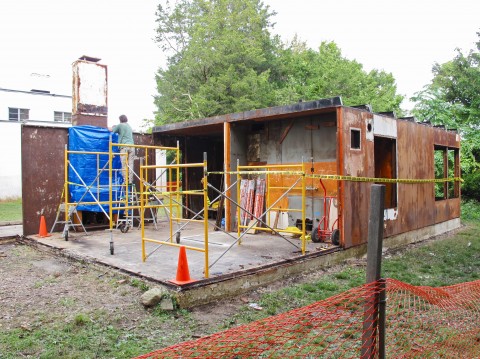A small steel house has fallen into disrepair at the eastern side of South Lot. The unassuming structure is in fact the product of a rich architectural history and holds a spot on both the State and National Registers of Historic Places. Manufactured by the Chicago-based General Houses Inc., this small house is among only a few of its kind that still exist today.
Winslow Ames, the art historian and founding director of the Lyman Allyn Art Museum, commissioned the house in 1933 after seeing it at the Century of Progress World’s Fair in Chicago. Along with many other prefabricated houses, the steel house was displayed at the fair as a modern and efficient solution to the housing crisis of the Great Depression. Steel panels measuring 4’ x 9’ were prefabricated and assembled on site to form a 21’ x 37’ rectangle that encloses two bedrooms, one bathroom, and an open kitchen / living room. The building was purchased by the college in 1949 and used as faculty housing until 2004, when it was determined that the house should be demolished. The house was subsequently boarded up until 2007, when a group of faculty, staff and students decided to save it.
With the help of generous grants from the Dr. Scholl Foundation, the Connecticut Trust for Historic Preservation, and a family foundation, the college has raised $100,000 to save this house.
Abigail Van Slyck, Associate Dean of the Faculty and an architectural historian, is working along with Doug Royalty, a historic preservation specialist, as well as a contracting group that specializes in preservation to restore the house. The deconstruction of the house has already begun and should be completed sometime next week. Once disassembled, the house will be shipped to Philadelphia, where it will be restored and shipped back to Connecticut College for reassembly. Daily updates of the disassembly and reassembly processes are provided by Rusty the Steel House (http://rustythesteelhouse.blogspot.com/), a blog run by student Alison Thomson. The college plans to use the refurbished space as offices for environmental groups on campus.
“The steel house is a very early example of modern architecture in the United States,” Van Slyck said. “It has long been thought that modern architecture was a European innovation brought here after World War II. These houses are examples of homegrown modernism in 1930s American architecture.”
Modern architecture has fallen victim to the harsh lens of cultural hindsight. As with many fashions of the past that have fallen out of favor, modern architecture is viewed with skepticism and is largely unappreciated by American culture (see the scorn shown for Shain Library. Not unlike what occurred with Victorian architecture in the 1960s and ’70s, many modern architectural treasures have been destroyed and replaced by “trendier” architecture. With patience and preservation, treasures of modern architecture can be preserved and appreciated, perhaps until they are embraced as “vintage.” The small House of Steel has provided Connecticut College with the opportunity to contribute to saving a piece of modernism and its rich architectural history. •









